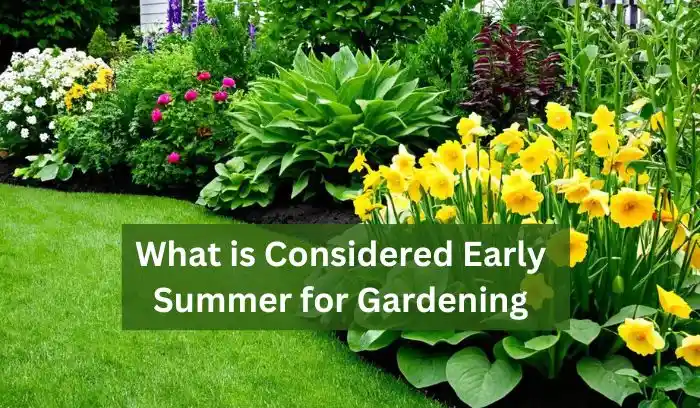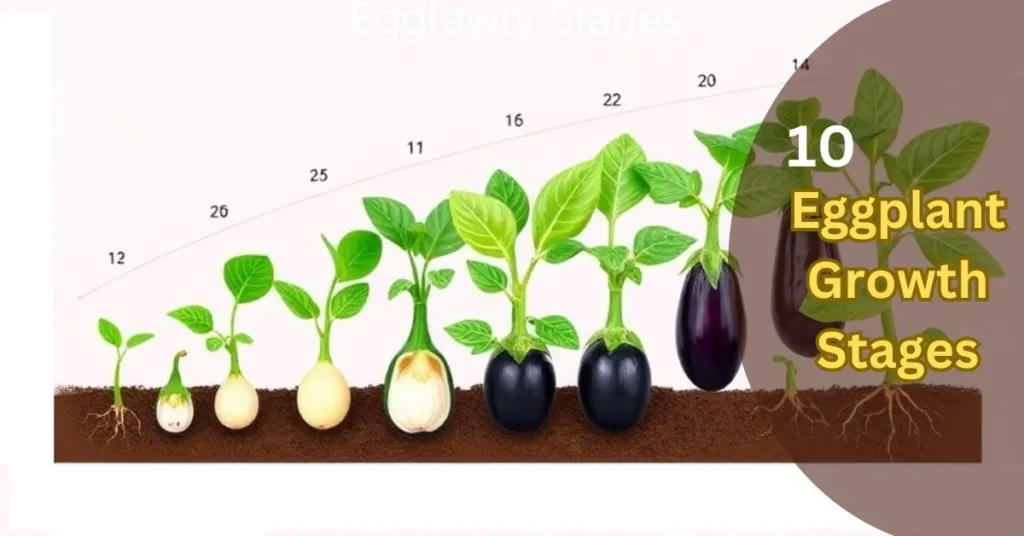Early summer is a special time for gardeners, as it marks the beginning of a new season filled with preparation and excitement. During this period, gardening takes on a new rhythm as temperatures rise, bringing warmer weather and more sunlight. Planning is crucial at this stage, as gardens need to be ready for the coming growth of flowers, vegetables, and crops.
The climate plays a key role in determining the best time for planting, with temperature, soil conditions, and frost being vital factors to consider. This is also when the first signs of bloom, flowering, and seedlings start to appear, marking the shift from the cool spring days to the more intense warmth of summer.
For gardeners looking to get a head start, early summer is a great time to focus on planting and caring for annuals, perennials, and other outdoor plants. As the days get longer and sunlight intensifies, growth accelerates, and it’s important to stay on top of the maintenance routine.
Ready your garden by checking the soil, ensuring it has the right nutrients, and making sure your plants have the proper water and sun exposure. Keep an eye on the weather forecast, as early summer can be a time of fluctuating conditions. Whether you’re planting seeds or dealing with the first sprouts, the environment will continue to change, requiring gardeners to adapt their schedules and maintain the health of their plants.
Key Points
| #- | Aspect | Details |
|---|---|---|
| 1- | Timing | Early summer typically starts in late May to early June in the U.S. |
| 2- | Temperature | Warm temperatures, usually between 60-80°F (15-27°C), ideal for planting warm-season crops. |
| 3- | Soil Conditions | Soil warms up, making it suitable for planting summer vegetables like tomatoes and peppers. |
| 4- | Sunlight | Longer days with increased sunlight help accelerate plant growth. |
| 5- | Crops to Plant | Warm-weather crops like tomatoes, peppers, cucumbers, zucchini, and herbs. |
| 6- | Watering Needs | Regular watering is essential due to warmer temperatures and increased evaporation. |
| 7- | Maintenance | Fertilizing soil, removing weeds, and checking for pests are key activities. |
| 8- | Frost Risk | Risk of frost has passed, making it safe for frost-sensitive plants to be planted. |
| 9 | Indoor Seed Starting | Indoor seeds for heat-loving plants like squash, eggplant, and lemongrass should be started early. |
What Does Early Summer Mean For Gardeners?
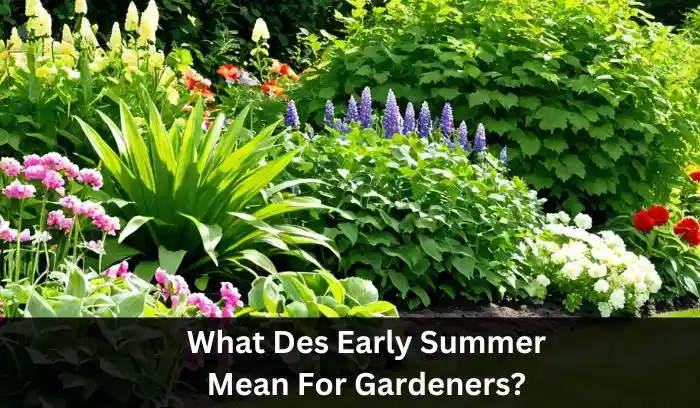
For gardeners, early summer marks a busy season filled with preparation and excitement. As we transition from spring to summer, there are significant changes in the garden. This period is favourable for planting many types of plants, especially vegetables, fruits, and flowers.
The weather becomes warmer, and the days are longer, creating perfect conditions for growth. As the temperature rises, it’s the ideal time for plants like tomatoes, cucumbers, bell peppers, zucchini, and basil to thrive.
During this phase, gardening becomes more focused on growing and maintaining healthy plants. The conditions become more suitable for growth, making it the best season to see your hard work pay off. Whether you’re planting new seeds or nurturing young seedlings, early summer offers the right balance of warm weather, sunlight, and longer days to support healthy growth and a bountiful harvest.
Importance of Timing in Gardening
When it comes to gardening projects, the timing of your tasks plays a crucial role in how well your plants will grow and produce. Each type of plant requires a specific period to grow well, and understanding the best timing for planting can lead to healthier crops.
For example, cool-weather crops like lettuce should be planted in early spring, while warm-weather plants like tomatoes thrive after the last frost. Getting this timing right ensures your garden gets off to a good start.
Once your plants are in the ground, maintaining a regular watering routine is essential, especially during hot weather. Watering your garden in the early morning allows the soil to absorb moisture before the heat of the day causes it to evaporate. Harvesting also depends on timing.
To enjoy fruits and vegetables at their best, you need to pick them at the perfect time. For instance, tomatoes should be fully coloured and firm before harvesting—waiting too long can result in overripe, tasteless fruit. With good timing, your garden can thrive and provide a bountiful, delicious harvest
What Is Considered Early Summer For Gardening
When Does Summer Start in The U.S.?
In the U.S., early summer is often considered to begin in late May, particularly in warmer regions. During this time, the weather is typically warm, but not yet too hot, making it an ideal time for planting. The soil conditions are also optimal for starting new plants.
However, the exact timing of early summer can vary by location. For instance, southern states might experience it as early as May, while northern parts of the country may not see valid summer-like conditions until mid-June.
This variation in the start of summer is important for gardeners and those planning outdoor activities. The different times that summer arrives in various regions mean that each area has its own unique season for growing and enjoying the outdoors. For example, in southern states, it might be possible to plant earlier, while in cooler climates, you’ll need to wait until the weather warms up more. Understanding when summer begins in your area helps you make the most of the season.
What Should I Do Before Summer For The Garden?
As summer approaches, it’s important to prepare your garden so that your plants thrive and your crops grow effectively. By late May, you should start planting summer crops to give them time to settle in before the heat of summer.
Fertilizing the soil is another crucial step to make sure the soil has the nutrients your plants need to grow strong and healthy. I’ve found that doing this in early summer ensures that the plants get the right support for their rapid growth during the warmer months.
Don’t forget to water your plants regularly, ideally in the morning, to prevent evaporation. This ensures that your garden receives consistent moisture all day long. Also, remove weeds as they can steal nutrients from your fruits and vegetables, leaving them vulnerable to pests.
Keeping the garden clean is essential to protect your crops. As pests become more active during summer, it’s vital to stay ahead of them by taking these steps early on to ensure your garden grows fast and produces high-quality, ripe produce.
Dates for Early Summer Gardening
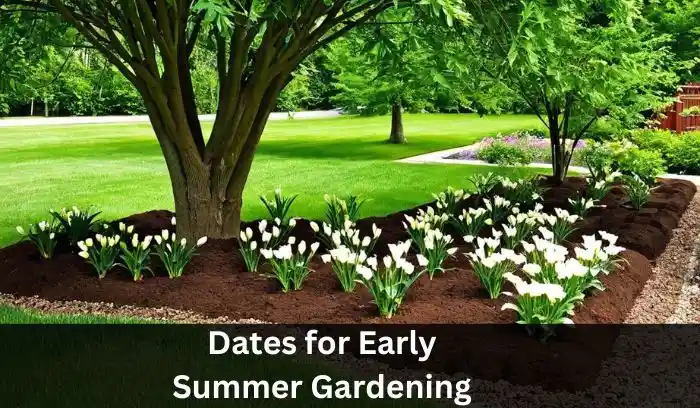
May 27 (Spring): Start Planting!
By May 27, the last frost in many parts of the U.S. is usually over, making it the perfect time to start planting. The soil should be warm enough to support the growth of summer vegetables like tomatoes, peppers, cucumbers, and zucchini. If you want to improve the quality of your soil, consider adding compost or fertilizer such as calcium carbonate.
This helps provide the essential nutrients for your crops to thrive. If you’re looking to speed up growth, indoor seeds for squash and eggplant are a great option as they grow faster when started early. Be sure to keep the soil moist so the seeds can sprout and grow strong.
If you’re growing heat-loving plants, such as lemongrass, now is an excellent time to plant them. Warm weather is essential for these plants, especially in Zone 9a, where you can make the most of the early summer gardening season. Remember, the end of spring marks a fresh start for all your garden plans, and these early planting tips will help your crops thrive as the weather heats up.
April (Spring): Enjoy Your Garden!
As April arrives, it’s the perfect time to check the progress of your spring crops like lettuce, spinach, and peas. These plants should be starting to thrive and grow strong in the soil. If you notice your seeds have begun to sprout, don’t worry—this could be due to the movement of worms, which is actually beneficial for the soil and your plants.
At this stage, it’s important to check for any signs of diseases, infections, or insects that may harm your crops. April is also a good time to start preparing for summer planting. Make sure your plants are healthy and free from any pests, as this will help them continue to grow well.
If you find any unhealthy plants, it’s best to act quickly. Whether you’re tending to your current crops or getting ready for the warmer months, the goal is to make your garden as productive and vibrant as possible.
June 21 (Summer): The Longest Day for Plants
On June 21, the longest Day of the year, plants experience their peak exposure to light, which is essential for growth. During this time, summer brings warmer temperatures and longer days, causing more evaporation.
This increase in evaporation means that plants will need more water to stay healthy. It’s a good practice to water your plants in the early morning when the temperatures are cooler, which helps retain moisture in the soil. This also minimizes evapotranspiration, ensuring that the plants get enough hydration throughout the day.
To help deter weeds and retain soil moisture, adding mulch is a great step. It’s also the perfect time to add compost or fertilizer to your garden to provide extra nutrients for your plants. With the longest day of the year, your plants will have the best chance to grow strong and healthy, so keep up with regular watering to ensure they thrive during this period of high evaporation.
July 4 (Summer): Check on Your Plants
On Independence Day, take a moment to step outside and check on your garden. This is the perfect time to assess how your summer crops are doing. You’ll want to look for any signs of disease or pests that could be affecting your plants. Common pests to watch out for include aphids, caterpillars, and beetles.
If you find any, use sustainable and natural methods to remove them, ensuring that your garden remains healthy without harming the environment. July is also the time when some of your early crops, like beans, cucumbers, and zucchini, might be ready for harvest.
As you harvest your produce, savor the results of your hard work. It’s a great way to motivate yourself to keep caring for your plants. As you celebrate this special Day, the satisfaction of having a thriving garden can add even more joy to the occasion.
August (Summer): Prepare for Fall Plants
As summer days increase, it’s vital to start planning for fall planting.August is an ideal time to get your garden ready for the upcoming cooler months. Consider planting cool-weather crops like kale, broccoli, and carrots, which thrive in cooler temperatures.
These crops can either be sown directly in the garden or started indoors if you prefer a head start. If you have any summer plants that are ready or done, it’s time to pull out the dead or drying ones to make space for your fall crops.
In addition, don’t forget to water your summer crops, as the heat may cause them stress. Keeping up with watering is essential to maintain their health while making room for new plants. Whether you’re planting in the garden or starting them indoors, this time is key to ensuring a smooth transition into fall gardening.
September 4 (Summer): Time to Harvest What You Grew
By early September, many of your summer crops like tomatoes, peppers, squash, and eggplants are ready for picking. It’s important to harvest them at the right time to get the best taste. For example, tomatoes should be fully coloured and feel a little soft when you touch them.
Timing is key for the best flavour, so keep an eye on your crops as they ripen. Once you’ve harvested your plants, don’t forget to save seeds from heirloom plants to plant again next year.
As you finish harvesting, it’s also a great time to clean up your garden beds and get them prepared for fall planting. Pull out any dead or dried plants, and give the soil a little extra care so it’s ready for new crops. Taking these steps ensures that your garden stays healthy and productive through the change of seasons.
What to Plant in Early Summer?
In early summer, it’s ideal to plant a mix of herbs, vegetables, and fruits. You can start with basil, oregano, and thyme for fresh herbs, while tomatoes, peppers, and cucumbers are perfect vegetables.
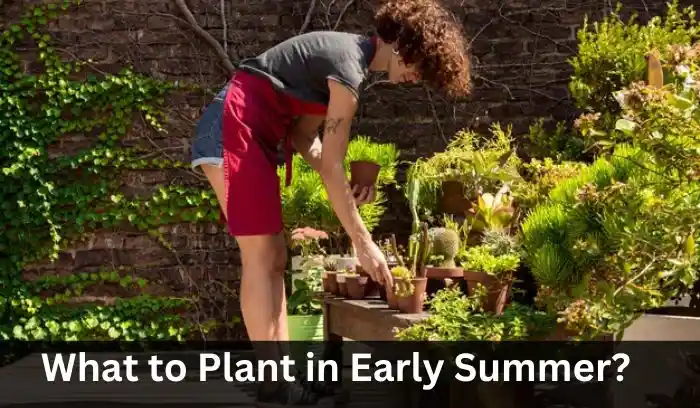
Add some carrots and squash for variety. If you’re into fruits, try watermelon, strawberries, and blueberries. Remember, harvest timing and results can vary, so plan according to each plant’s range to enjoy the best harvests throughout the season!
| Category | Plants | Notes |
|---|---|---|
| Herbs | Basil, Oregano, Thyme, Cilantro, Parsley | Best for flavor and fresh use |
| Vegetables | Tomatoes, Peppers, Cucumbers, Carrots, Zucchini, Squash | Thrives in warmer weather |
| Fruits | Watermelon, Cantaloupe, Strawberries, Blueberries | Sweet and refreshing, great for summer |
| Planning | Consider harvest timing, ranges, and results | Results vary based on type |
When to Fertilize Your Garden?
The right time to fertilize your garden depends on your plants. Generally, spring or early summer is the best time to add fertilizer because plants start to grow quickly during this period. This is when they require nutrients the most to enhance their growth.
You can use natural fertilizers like calcium carbonate, which is great for soil health and will help your plants thrive. Be sure to apply the right amount of fertilizer to avoid overfeeding. Fertilization should not be done too late in the growing season.
If you fertilize too close to the cold weather, new leaves may form but won’t have enough time to grow properly. Also, be mindful of feeding your plants when they’re making flowers or fruits—this is when they need extra nutrients. Using compost according to the directions on the package ensures the plants get the right balance of nutrients.
What is probably the timing of fertilizer to give soil or plants?
Fertilizing your garden helps ensure your plants grow healthy and robust. The best time to apply fertilizer is in March or April, right before you plant seeds or seedlings. This will give the soil the nutrients it needs during the early growth process. You want your plants to have a good start, so it’s crucial to fertilize at the right time.
As the growing season progresses, it’s also a good idea to fertilize again in June to early July, when the plants need more nutrients to produce fruits and flowers. If you are growing long-growing vegetables like tomatoes and peppers, you can even light-feed them from late July to August to make sure they continue to produce. Timing is key, so always follow the plant’s needs throughout the season.
Watering Schedule for Early Summer
As early summer arrives and temperatures rise, plants begin to require more water to stay healthy and grow. The heat of the season can dry out the soil quickly, so it’s important to adjust your watering routine to meet the plants’ needs.

Watering in the morning is ideal, as it gives plants a chance to take in moisture before the day’s heat arrives. Watering 2 to 3 times a week is usually enough, but the frequency may vary depending on several factors, including the type of plants you have, the kind of Fertilization should not be done too late in the growing season.
If you notice that the soil dries out faster, you may need to water daily, especially during particularly hot days. To determine when your plants need water, simply check the top inch of the soil. It is time to irrigate the soil if it seems dry.
When you do water, make sure the moisture penetrates 1 to 2 inches deep into the soil, ensuring that the water reaches the plant roots where it’s needed most. Proper watering encourages strong root growth and helps your plants withstand the heat, promoting overall plant health.
Pest Control Timing
The right timing for pest control in your garden is crucial for effectiveness. Pests tend to be more active during the morning or evening, making these the best times for control. The cooler temperatures during these times, especially in summer, prevent your plants from getting stressed by the heat, while allowing the pest-preventing treatment to work effectively without the risk of harm.
If you want your garden to thrive, applying spray or other treatments early in the morning ensures that pests are targeted at their most active phase.
Another important factor is ensuring you are using the right garden soil, especially if you’re buying it in bulk. Properly storing the soil helps prevent root causes of pest production. Always check your plants for any signs of pests before you apply any treatments to keep your garden healthy and thriving.
Gardening Tasks for Early Summer
Planting Warm-Season Crops
When the weather gets warm and the heat is just right, it’s time to start planting warm-season crops that love the sun. Some of the best vegetables to plant during this season include tomatoes, peppers, cucumbers, squash, and beans.
These crops thrive when they receive plenty of sunlight and heat, growing quickly to provide you with delicious harvests. In addition to vegetables, you can also plant beautiful flowers like zinnias, marigolds, sunflowers, and petunias, which bring vibrant colors to your garden.
Make sure to plant these crops early enough so they can thrive throughout the season. Whether you’re growing vegetables for a tasty home-cooked meal or flowers to add charm to your garden, the key is to provide the right amount of heat and care. Keep an eye on the weather to make sure the soil is warm enough for these plants to establish their roots and grow strong.
Watering and Mulching
As temperatures rise, it’s important to focus on moisture retention to keep your plants healthy. Watering should be done more frequently, but always make sure to water deeply to encourage root growth. This method helps the roots to reach down into the soil, promoting better plant health in the long run.
Another great way to conserve moisture is through mulching. By applying a 2-3 inch layer of organic mulch, you can suppress the growth of weeds while also keeping the soil moist for longer periods. This combination of watering and mulching is key to thriving plants in the heat.
Mulch not only helps with moisture retention, but it also improves the soil’s quality as it breaks down over time. A good layer of organic mulch works wonders in maintaining soil temperature, keeping it cooler in the summer and warmer in the winter. By regularly adjusting your watering frequency and ensuring your plants are well-mulched, you’ll create an ideal environment that helps plants thrive.
Pest Control and Disease Prevention
Effective management of garden pests is crucial for healthy plants. Early detection of pests such as aphids, caterpillars, and beetles is vital to prevent long-term damage. It’s important to inspect your plants regularly and check for any signs of pest infestation. A simple visual inspection can help identify potential issues before they spread.
Use natural solutions like introducing helpful insects like ladybugs or organic pesticides for a more natural approach. These insects help control pests without harming your plants or the environment. By staying proactive, you can ensure that your garden remains healthy and free from harmful pests.
Fertilizing
To ensure your plants grow strong and healthy, it’s important to support their rapid growth with the right care. First, you’ll need to choose a fertilizer that suits the specific plant type you’re working with. A balanced fertilizer can provide essential nutrients, but you may also need one tailored to particular plants depending on their needs.
Once you’ve selected the correct product, always follow the manufacturer’s instructions carefully. This includes understanding the timing and quantity for application. Applying too much or too little can harm your plants, so be sure to get it just right.
Remember, the success of your garden depends on feeding your plants properly. Proper fertilizing ensures they have the nutrients they need for optimal growth, helping them thrive throughout the season.
Flowers
Marigolds
Marigolds are a fantastic choice for any garden, not just for their vibrant color but also for their ability to deter pests. These bright and cheerful flowers not only beautify the space but also act as a natural pest repellent. They add a burst of orange or yellow, making any garden feel more lively while keeping unwanted insects at bay.
Marigolds are especially helpful when planted near vegetables or other flowers, as their scent helps deter bugs like aphids and nematodes. By incorporating marigolds into your garden, you can enjoy both their beauty and their ability to create a healthier growing environment.

From my own experience, I’ve noticed that marigolds do an excellent job in my garden of helping to keep pests away from more vulnerable plants. Not only do they enhance the look of the garden with their vibrant color, but they also reduce the need for chemical pesticides, which is a win for the environment. If you’re looking for a low-maintenance flower that offers both aesthetic and practical benefits, marigolds are the perfect choice!
Petunias
Petunias are perfect for anyone looking for vibrant and attractive flowers in their garden. These hardy annuals bloom through the summer, adding bright, long-lasting colors to any space. Whether you want them in your flower bed or as part of container gardening, petunias thrive in sunny spots with easy-care and low-maintenance needs.
They are also drought-tolerant, making them ideal for warmer temperatures and dry conditions.
What makes petunias truly stand out is their ability to grow in various gardens and adapt to different growth conditions. They are versatile, and their vibrant colors can be mixed to create an attractive display. Petunias are easy to grow and will thrive without too much effort, making them a go-to choice for both beginner and experienced gardeners.
Sunflowers
One of the simplest flowers to cultivate in your garden is the sunflower. They thrive in warm soil and require plenty of sunlight to produce their large, bright, and vibrant blooms. These annuals grow tall and are perfect for adding a pop of colorful beauty to your garden space.
Sunflowers are also beneficial for the environment as they attract pollinators like bees and butterflies, which are essential for healthy ecosystems. With the right conditions, they can bloom all summer long and offer seeds that feed wildlife.
Planting sunflowers can help you create an attractive, thriving garden while supporting bees, butterflies, and other pollinators. Their growth in the outdoor garden makes them an ideal choice for anyone looking to enhance their garden’s aesthetic and encourage wildlife. Sunflowers not only provide beauty but also contribute to the overall health of the garden by improving the conditions for other plants to thrive.
Zinnias
Zinnias are perfect for those who want to add bright, vibrant color to their gardens. These flowers thrive in full sun and heat, making them an excellent choice for the summer months.
Known for their long-lasting blooms, they are drought-tolerant and require little garden care, making them ideal for busy gardeners or those looking for easy-care annuals. Their ability to tolerate heat and dry conditions means they will keep blooming even in challenging weather.
Zinnias not only bring a pop of color but also attract bees, pollinators, and wildlife, making them beneficial for the outdoor garden environment. These low-maintenance plants offer an affordable way to enhance garden space while supporting thriving ecosystems. Whether you’re a seasoned gardener or just starting, Zinnias are a great choice for adding beauty and growth to your space.
Crops and Plants Best Suited for Early Summer
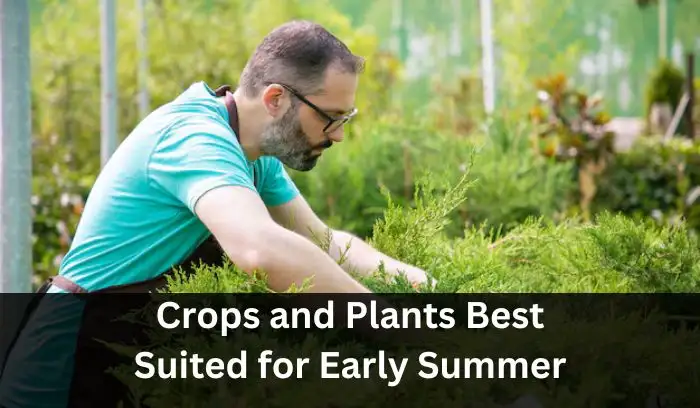
Vegetables
Tomatoes
Tomatoes are one of the best suited crops for your garden, especially when you’re looking to plant in early summer. These plants thrive in heat and can produce abundantly when given the right care. When selecting tomatoes for your garden, it’s important to pick varieties that love the warmth and are tailored for your growing zone.
The right conditions, including ample sunlight and warmth, are essential for a successful harvest. In my experience, growing tomatoes can lead to great success in the garden, especially when you ensure they get plenty of heat and sunlight.
Whether you are a seasoned gardener or a beginner, with the proper care, tomatoes can be a rewarding and fruitful choice. You will be amazed at how much they can produce with just a little attention. It’s truly satisfying to see your garden flourish with these vibrant red fruits!
Squash
When planning your garden, squash is a great option to consider. Both summer and winter varieties of squash can be planted now, making it a versatile choice for the growing season. Summer squash tends to mature quickly, producing tender, edible fruits that are perfect for warm weather, while winter squash offers hardier varieties that thrive as temperatures cool.
Whether you’re growing squash for immediate harvest or planning for the colder months, selecting the right varieties can really help with your garden’s success. It’s important to plant at the right time to ensure a healthy and productive crop.
Planting squash now ensures a bountiful harvest later, as it grows rapidly in favorable conditions. From zucchini to butternut squash, the options are plenty. The key is knowing when to plant, how to care for them, and choosing the right varieties based on your garden’s needs. With the right preparation, you’ll have plenty of squash to enjoy throughout the year.
Beans
If you’re looking to grow vegetables that are easy and fast to harvest, beans are an excellent choice. These quick-growing plants thrive in warm soil, making them ideal for spring and summer gardens. Whether you’re planting for fresh eating or for storage, beans will offer high yields in a relatively short time, making them a great crop for both beginners and experienced gardeners.
Beans are also versatile in the garden. You can grow them as standalone crops or in combination with other plants, enriching the soil with nitrogen and promoting overall garden health. Whether you’re planting vegetables in raised beds or containers, beans will fit into most garden plans with ease. Warm soil helps them reach their full potential, giving you a bountiful harvest in no time.
Corn
Corn is one of the most rewarding vegetables to grow in a garden. It requires warm temperatures and plenty of sun to thrive. This crop needs long days and the right growth conditions to fully mature.
For the best results, plant it during the summer season, when the heat is at its peak. Corn also grows best in rich, well-drained soil that can hold moisture. If the plant gets enough warmth and sunlight, it will produce bountiful crops that are perfect for cooking and eating fresh.
In terms of agriculture, corn is a staple crop that has been cultivated for centuries. Its ability to thrive under heat makes it a favorite in regions with long, hot seasons. So, if you’re looking for a high-yielding crop that loves the sun, corn should be on your list!
Herbs
Basil
Basil is an aromatic herb that thrives in warm weather and is perfect for your garden. It loves full sunlight and grows well in well-drained soil, making it an excellent choice for companion planting. With its vibrant green leaves, basil not only adds flavor to your kitchen but also acts as a pest-repellent, keeping harmful insects away from other vegetables in your garden.
Known for its fragrant scent, basil grows quickly in summer and offers easy-care maintenance. In addition to its culinary uses, basil can thrive in both outdoor and indoor garden space, provided the temperature and conditions are right. It is a beneficial plant that supports healthy growth and can boost the growth rate of nearby plants.
Whether grown for its flavorful leaves or its ability to attract beneficial insects like bees, basil is an easy and rewarding annual to grow. When you’re ready, you can enjoy the harvest of this vibrant herb that adds both color and flavor to your dishes.
Oregano
Oregano is an incredibly easy-to-grow herb that thrives in full sun and well-drained soil. It’s well-suited for outdoor gardens and even vegetable patches, as it enhances the flavor of dishes while being a beneficial companion plant.
Oregano prefers warm temperatures and can withstand the heat of summer, making it a perfect addition to your garden, even in dry conditions. This low-maintenance plant not only adds vibrant green leaves to your garden but also thrives with little effort, requiring only a healthy amount of sunlight and occasional watering.
When it comes to culinary uses, oregano is a flavorful and aromatic herb that adds a robust, fragrant kick to many dishes. Whether used in Italian cooking or as a topping for vegetables, oregano is a must-have in any kitchen garden.
Known for being drought-tolerant and pest-repellent, it helps keep your garden space both thriving and healthy. It’s a true companion plant that grows well alongside other vegetables and plants, making it an excellent choice for those looking to create a vibrant, sustainable garden. The growth rate is steady, ensuring you have a consistent supply of fresh leaves to harvest throughout the growing season.
Thyme
Thyme is an aromatic and versatile herb that thrives in hot and dry conditions, making it ideal for Mediterranean climates. This drought-resistant plant is not only valued for its strong flavor, which enriches a variety of culinary dishes, but also for its healing properties.
Packed with antioxidants and antibacterial qualities, thyme offers a wide range of benefits, from boosting the immune system to aiding in respiratory health. Whether in the kitchen or in natural remedies, its leaves are a great addition to any garden or herbal remedy collection.
When it comes to garden care, thyme requires minimal maintenance due to its ability to flourish in soil with good drainage and sun exposure. It’s a hardy herb that can withstand summer heat and continue to grow with little water, making it perfect for gardeners in areas with low moisture.
Additionally, thyme’s flavor profile is rich, providing both a subtle taste and a soothing scent. Its high nutrient content makes it a beneficial addition to any garden, helping to improve soil quality and creating a perfect environment for other plants to grow.
Common Mistakes in Early Summer Gardening
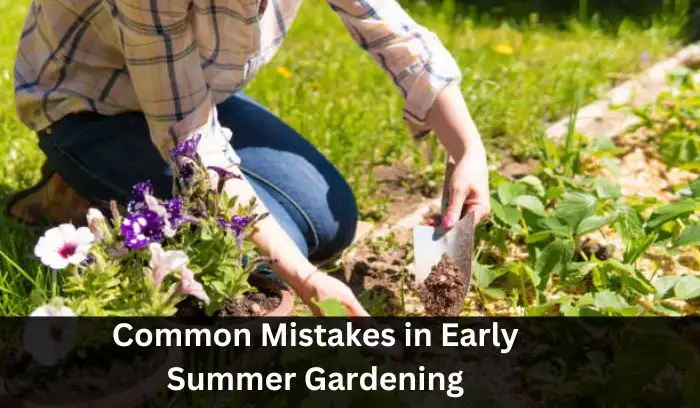
One of the biggest mistakes in early summer gardening is planting too late. Delaying the planting process can shorten the growing season, leading to smaller harvests and reduced yield.
Late-planted seedlings may struggle to establish roots before the peak summer heat, causing them to be more vulnerable to heat stress. It’s important to plant at the right time so your plants have enough time to grow strong before the heat of summer kicks in.
Another common issue is improper watering. Overwatering can lead to root rot and fungal diseases, while underwatering stresses the plants, making them more susceptible to pests and poor growth.
Ignoring soil health is also a problem—if you fail to amend your soil with the essential nutrients your plants need, you can deprive them of what they require for healthy development. Mulching helps prevent soil erosion, reduces moisture loss, and keeps the soil in top condition, which is essential for preventing degradation and ensuring steady growth.
Conclusion
Early summer is a crucial time for gardeners, marking the start of a new season full of preparation. As temperatures rise and sunlight increases, plant growth accelerates, making it essential to maintain a good routine. The timing of planting is key—cool-weather crops like lettuce should be planted early, while warm-weather plants like tomatoes thrive after the last frost. Regular watering is important, especially in hot weather, to prevent moisture loss.
Proper timing also ensures crops are harvested at their peak for the best flavor. In the U.S., summer typically begins in late May, with ideal conditions for planting. By then, it’s time to start planting summer vegetables such as tomatoes, peppers, and zucchini.
Improve soil quality with compost and calcium carbonate. Indoor seeds for heat-loving plants like squash and lemongrass should be started early. In April, check on spring crops like lettuce and spinach for healthy growth and monitor for pests or diseases to ensure a successful harvest.
See Also:
How to Grow Plants Along a Vinyl Fence: Step-by-Step Guide
Why Are Seeds Popping Out of the Soil When Worms Fertilize?

